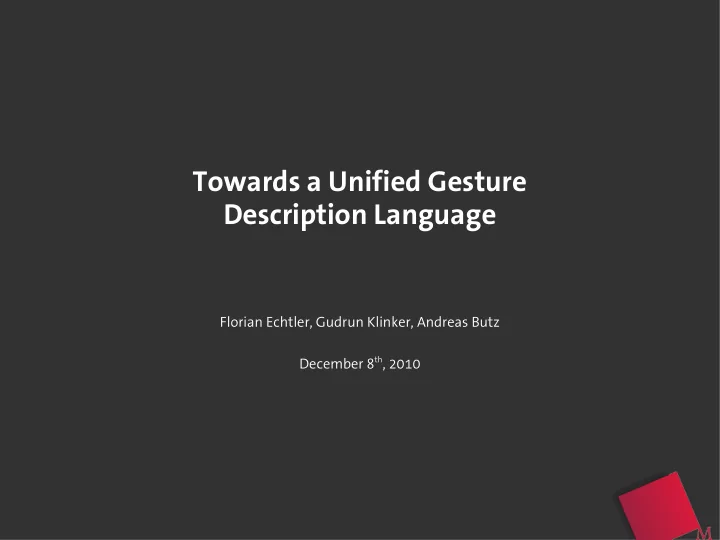

Towards a Unified Gesture Description Language Florian Echtler, Gudrun Klinker, Andreas Butz December 8 th , 2010
Motivation gesture-based input can mean many things touchscreens („multitouch“) ● input from multiple users ● input with multiple fingers/hands ● multiple conventional pointers ● tangible interfaces ● everyday items ● mobile devices ● fiducial markers ● ● free-air gestures ● assisted (Wiimote) unassisted (Kinect) ● ● Imagine porting an iPad app to a wall display with Wiimotes... ➔ => is there a common denominator for these interfaces? ➔ ● Towards a Unified Gesture Description Language 2/9
Motivation What is a gesture? common gesture descriptions allow... ● user customization ● faster development ● ● difficult question: what is a gesture? ● answer within this context: ● any motion(s) which the user executes to achieve a certain response directly leads to the next question: ● how can these motions be described? Towards a Unified Gesture Description Language 3/9
Concepts Abstract Description of Gestures Three core elements: Regions, Gestures, Features Towards a Unified Gesture Description Language 4/9
Concepts Abstract Description of Gestures Regions: ● spatial areas defined in reference coordinates ● extension of „traditional“ WIMP-UI window objects ● Gestures: ● sequences of features, either ... ● ● pre-defined by capability description or ... ● customized by application Features: ● geometrical/mathematical properties of input data, e.g.: ● ● motion vector ● relative rotation ● travelled path further classification through filters and constraint values ● Towards a Unified Gesture Description Language 5/9
Concepts Examples of Available Features Motion – average motion vector ● Rotation – rotation around center of mass ● Scale – scaling w.r.t. center of mass ● Path – recognize „shape-based“ gestures ● ● ObjectCount – number of objects inside region ● ObjectDimensions – describes shape of object ● ObjectOrientation – rotation relative to reference frame ● ObjectPosition – absolute position of object ● ObjectID – unique ID (e.g., fiducial marker) of an object ● ● Towards a Unified Gesture Description Language 6/9
Examples Rotation Gesture simple example: „ rotate “ gesture (contains one Rotation feature) ● ● rotate default RelativeObjectRotation 255 0 6.28 0 ● Name Flags Feature Mask Lower... Upper limit Result ● result value generated through... ● multi-finger rotation or ● object rotation or ● mouse wheel or ... ● Towards a Unified Gesture Description Language 7/9
Examples Composite Gesture slightly more complex example: horizontal swipe with two fingers ● ● swipe oneshot ● Motion 1 // filters (bitmask, only match fingers) ● ● 100 0 0 // lower limits ● 1000 10 10 // upper limits ● 0 0 0 // result (empty) ObjectCount 1 2 2 0 Result (only when constraints match): (3-vector, integer) = motion vector + object count ● ● mapping is dependent on... ● hardware capabilities user preferences ● => application doesn't have to care ➔ Towards a Unified Gesture Description Language 8/9
Thank you for your attention! Questions & comments? Towards a Unified Gesture Description Language 9/9
Recommend
More recommend